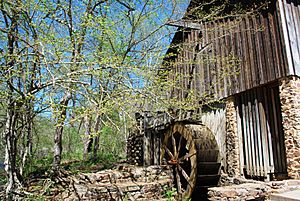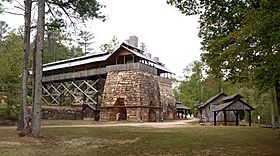Tannehill Ironworks facts for kids
Quick facts for kids Tannehill IronworksHistorical State Park |
|
|---|---|

John Wesley Hall Grist Mill
|
|
| Lua error in Module:Location_map at line 420: attempt to index field 'wikibase' (a nil value). | |
| Location | Tuscaloosa County, Alabama, United States |
| Area | 1,500 acres (610 ha) |
| Elevation | 427 ft (130 m) |
| Established | 1969 (opened 1971) |
| Administered by | Alabama Historic Ironworks Commission |
| Designation | Alabama state park |
|
Tannehill Furnace
|
|
 |
|
| Location | Tuscaloosa County, Alabama, United States |
| Area | 66 acres (27 ha) |
| Built | 1859-62 |
| Built by | Hillman, Daniel |
| NRHP reference No. | 72000182 |
| Added to NRHP | July 24, 1972 |
The Tannehill Ironworks is a really cool historical place in Tuscaloosa County, Alabama. It's the main attraction of the Tannehill Ironworks Historical State Park, located near the small town of McCalla. This site is so important that it's on the National Register of Historic Places as the Tannehill Furnace.
During the American Civil War, these ironworks were super important. They made a lot of iron for Confederate weapons. Today, you can still see the old furnaces. They are about 12 miles (19 km) south of Bessemer, close to the southern part of the Appalachian Mountains.
The park covers a huge area of 1,500 acres (607 ha). Besides the old furnaces, you can also visit the John Wesley Hall Grist Mill, the May Plantation Cotton Gin House, and the Iron & Steel Museum of Alabama. It's a great place to learn about history and see how things were made long ago!
Contents
Welcome to Tannehill Ironworks Park!
Tannehill Ironworks Historical State Park is a fantastic spot to explore history. It shows how important ironmaking was in Alabama. The park helps us remember a time when iron was made by hand. It also highlights the role this area played during the Civil War.
A Look Back: How Iron Was Made
Ironmaking started here in 1830. A man named Daniel Hillman Sr. built a bloomery forge. This was a simple type of furnace used to make iron. Later, between 1859 and 1862, three bigger furnaces were built. A famous iron builder named Moses Stroup designed them.
These new furnaces were called charcoal blast furnaces. They could make 22 tons of "pig iron" every day! Pig iron was raw iron that looked like pigs lined up. Most of this iron was sent to Selma, Alabama. There, it was used to make guns and weapons for the Confederate navy. Two of the furnaces used hot blast stoves and a steam engine to work even better. The iron ore, which is rock containing iron, came from mines just two miles (3 km) away.
The Civil War and Tannehill
The Tannehill furnaces also had a foundry. This was a place where metal was melted and poured into molds. They made cooking pots and other metal containers for the southern troops. But on March 31, 1865, during a military attack called Wilson's Raid, U.S. soldiers attacked and burned the furnaces and foundry.
Even though they were burned, the ruins are still there today. They are some of the best-preserved 19th-century iron furnace sites in the southern United States. It's like stepping back in time to see them!
Tannehill's Lasting Impact
The Tannehill Ironworks was also known as the Roupes Valley Iron Company. It had a big influence on how the iron and steel industry grew in Birmingham. In 1862, an important experiment happened at Tannehill. It showed that a type of rock called red iron ore could be used successfully in Alabama's blast furnaces.
This test was encouraged by people who were building the South & North Railroad. Because of this success, the government decided to build more iron factories in the Birmingham area. This helped Birmingham become a major center for iron and steel.
Today, the furnace ruins are recognized as an important historical landmark. The park is also an American Battlefield Trust Heritage Site. It's a stop on the Alabama Appalachian Highlands Birding Trail, too. In 2016, it was even named one of the top 10 parks and nature areas to visit in Alabama!
More to Explore
- Birmingham District
- Brierfield Furnace
- Shelby Ironworks

